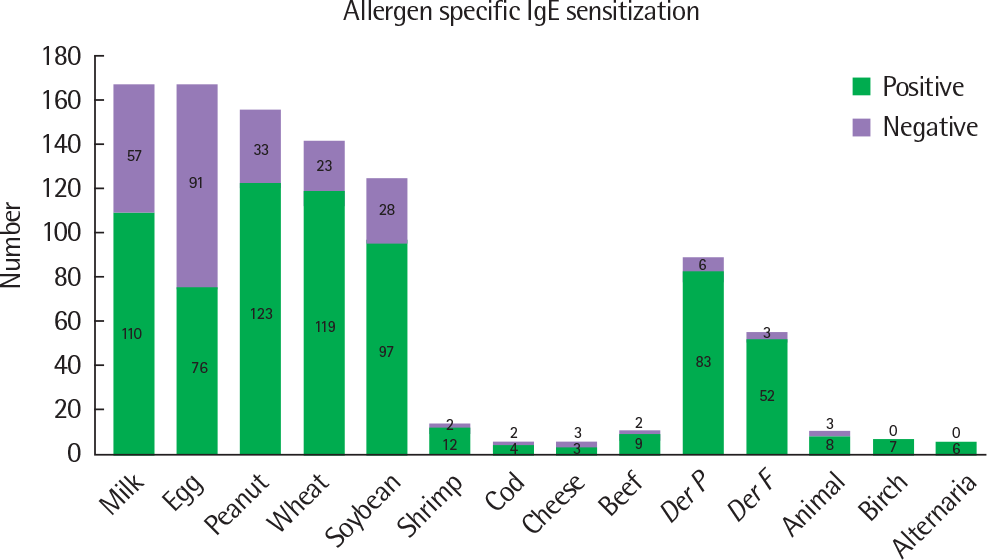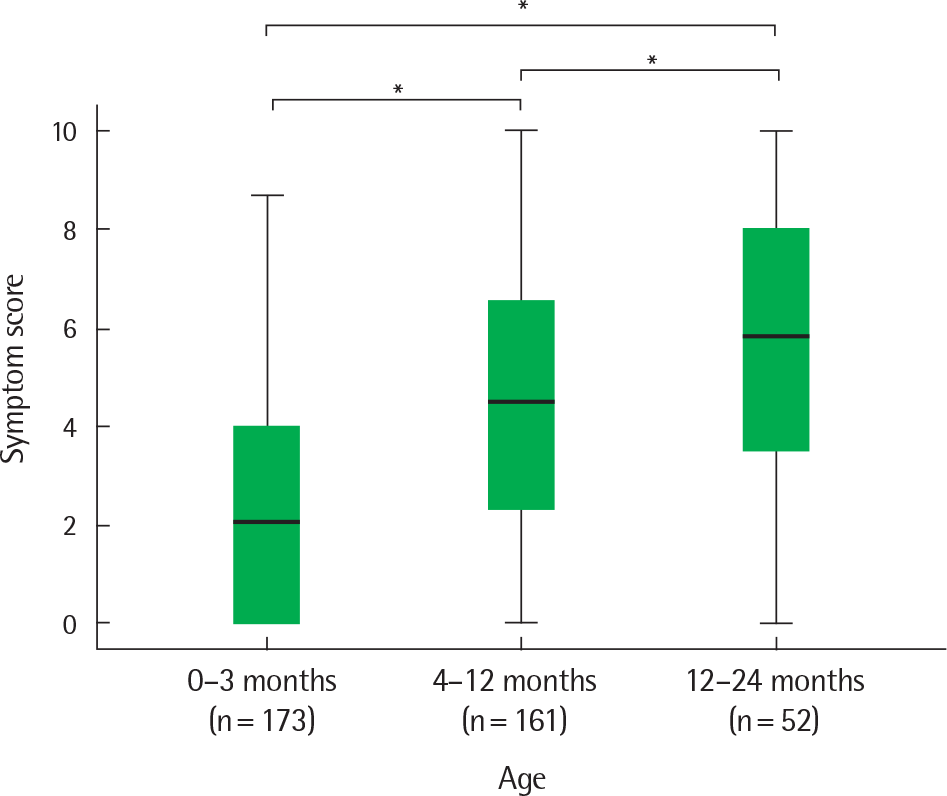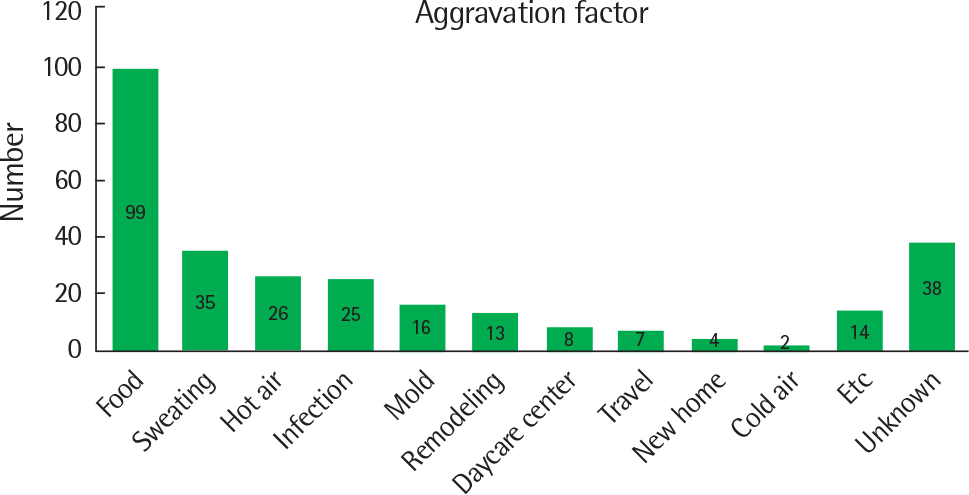Abstract
Purpose
Few studies have demonstrated the effects of aeroallergen sensitization on the development of atopic dermatitis (AD) in young children. This study aimed to investigate the sensitization rate of food and aeroallergens in AD patients under 2 years of age and to compare clinical characteristics between IgE- and non-IgE-mediated AD patients.
Methods
Children aged less than 2 years who had visited CHA Bundang Medical Center from 2013 through 2016 were enrolled. Allergen sensitization was measured by specific IgE levels for common allergens. Detailed information was obtained using an atopy questionnaire.
Results
A total of 173 patients were examined, 118 (68.2%) were male patients. The prevalence of aeroallergen sensitization under 1 year of age was 4.8% and increased to 19.5% for children aged 2 years (P=0.005). The mean age (13.6±6.3 months vs. 9.0±5.1 months, P=0.003) and the proportion of children born prematurel (15.4% vs. 2.3%, P=0.013) were higher in the aeroallergen-sensi-tized group than in nonsensitized group. Sensitization to food allergens between children aged less than 1 year and 2 years ap-peared to be similar (61.1% vs. 57.1%, P=0.651). There were no significant differences in clinical characteristics between food allergen IgE-mediated and non-IgE-mediated AD children.
Conclusion
Aeroallergen sensitization increased markedly in AD patients aged 2 years which is about 4 times that of the general population. However, there were no significant differences in clinical manifestations between allergen IgE-mediated and non-IgE-mediated AD children in both food and aeroallergens.
Go to : 
REFERENCES
1. Spergel JM, Paller AS. Atopic dermatitis and the atopic march. J Allergy Clin Immunol. 2003; 112(6 Suppl):S118–27.

2. Illi S, von Mutius E, Lau S, Nickel R, Grüber C, Niggemann B, et al. The natural course of atopic dermatitis from birth to age 7 years and the association with asthma. J Allergy Clin Immunol. 2004; 113:925–31.

3. Wüthrich B. Clinical aspects, epidemiology, and prognosis of atopic dermatitis. Ann Allergy Asthma Immunol. 1999; 83:464–70.

4. Kim JP, Chao LX, Simpson EL, Silverberg JI. Persistence of atopic dermatitis (AD): a systematic review and metaanalysis. J Am Acad Dermatol. 2016; 75:681–7.e11.

5. Chiu CY, Huang YL, Tsai MH, Tu YL, Hua MC, Yao TC, et al. Sensitization to food and inhalant allergens in relation to atopic diseases in early childhood: a birth cohort study. PLoS One. 2014; 9:e102809.

6. Just J, Deslandes-Boutmy E, Amat F, Desseaux K, Nemni A, Bourrat E, et al. Natural history of allergic sensitization in infants with early-onset atopic dermatitis: results from ORCA Study. Pediatr Allergy Immunol. 2014; 25:668–73.

7. Sybilski AJ, Zalewska M, Furmańczyk K, Lipiec A, Krzych-Fałta E, Samoliński B. The prevalence of sensitization to inhalant allergens in children with atopic dermatitis. Allergy Asthma Proc. 2015; 36:e81–5.

8. Williams H, Stewart A, von Mutius E, Cookson W, Anderson HR. International Study of Asthma and Allergies in Childhood (ISAAC) Phase One and Three Study Groups. Is eczema really on the increase world-wide? J Allergy Clin Immunol. 2008; 121:947–54.e15.

9. Roerdink EM, Flokstra-de Blok BM, Blok JL, Schuttelaar ML, Niggemann B, Werfel T, et al. Association of food allergy and atopic dermatitis exacerbations. Ann Allergy Asthma Immunol. 2016; 116:334–8.

10. Wisniewski JA, Agrawal R, Minnicozzi S, Xin W, Patrie J, Heymann PW, et al. Sensitization to food and inhalant allergens in relation to age and wheeze among children with atopic dermatitis. Clin Exp Allergy. 2013; 43:1160–70.

11. Kulig M, Bergmann R, Klettke U, Wahn V, Tacke U, Wahn U. Natural course of sensitization to food and inhalant allergens during the first 6 years of life. J Allergy Clin Immunol. 1999; 103:1173–9.

12. Makhija MM, Robison RG, Caruso D, Cai M, Wang X, Pongracic JA. Patterns of allergen sensitization and self-reported allergic disease in parents of food allergic children. Ann Allergy Asthma Immunol. 2016; 117:382–6.e1.

13. Gulbahar O, Sin A, Mete N, Kokuludag A, Kirmaz C, Sebik F. Sensitization to cat allergens in non-cat owner patients with respiratory allergy. Ann Allergy Asthma Immunol. 2003; 90:635–9.

14. Bollinger ME, Eggleston PA, Flanagan E, Wood RA. Cat antigen in homes with and without cats may induce allergic symptoms. J Allergy Clin Immunol. 1996; 97:907–14.

15. Almqvist C, Larsson PH, Egmar AC, Hedrén M, Malmberg P, Wickman M. School as a risk environment for children allergic to cats and a site for transfer of cat allergen to homes. J Allergy Clin Immunol. 1999; 103:1012–7.

16. Jones AC, Miles EA, Warner JO, Colwell BM, Bryant TN, Warner JA. Fe-tal peripheral blood mononuclear cell proliferative responses to mito-genic and allergenic stimuli during gestation. Pediatr Allergy Immunol. 1996; 7:109–16.

17. Kuitunen M, Savilahti E, Sarnesto A. Human alpha-lactalbumin and bo-vine beta-lactoglobulin absorption in infants. Allergy. 1994; 49:354–60.
18. Siltanen M, Kajosaari M, Pohjavuori M, Savilahti E. Prematurity at birth reduces the long-term risk of atopy. J Allergy Clin Immunol. 2001; 107:229–34.

19. Kvenshagen B, Jacobsen M, Halvorsen R. Atopic dermatitis in premature and term children. Arch Dis Child. 2009; 94:202–5.

20. Rhodes HL, Thomas P, Sporik R, Holgate ST, Cogswell JJ. A birth cohort study of subjects at risk of atopy: twenty-two-year follow-up of wheeze and atopic status. Am J Respir Crit Care Med. 2002; 165:176–80.
21. Rhodes HL, Sporik R, Thomas P, Holgate ST, Cogswell JJ. Early life risk factors for adult asthma: a birth cohort study of subjects at risk. J Allergy Clin Immunol. 2001; 108:720–5.

22. Gustafsson D, Sjöberg O, Foucard T. Development of allergies and asthma in infants and young children with atopic dermatitis–a prospective follow-up to 7 years of age. Allergy. 2000; 55:240–5.
23. Ohshima Y, Yamada A, Hiraoka M, Katamura K, Ito S, Hirao T, et al. Early sensitization to house dust mite is a major risk factor for subsequent development of bronchial asthma in Japanese infants with atopic dermatitis: results of a 4-year followup study. Ann Allergy Asthma Immunol. 2002; 89:265–70.

Go to : 
 | Fig. 1.Allergen specific IgE sensitization rates of food and aeroallergens. Aeroallergen specific IgE levels of 31 food allergens and 10 aeroallergens were measured in 173 children. The figure shows the test items of more than 5 times. Positive means specific IgE≥0.35 kIU/L. Der p, Dermatophagoides ptero-nyssinus; Der f, Dermatophagoides farina. |
 | Fig. 2.Comparison of symptom scores between different age groups. Symptom scores were measured every month after birth using questionnaires answered by parents. Total 173 subject's symptom score were divided to 3 groups (0 to 3 months, 4 to 12 months, and 12 to 24 months) and the average symptom scores of each group were compared. Box=25th and 75th percentiles; bars=min and max values. P-values refer to the comparisons indicated by the marker (Bonfer-roni, ∗ P<0.05). |
 | Fig. 3.Parent reported causes of atopic dermatitis answered by questionnaires. Total 173 subjects participated and multiple responses were allowed. Remodeling means remodeling of their house. New home means moving to a new house. |
Table 1.
Baseline characteristics of study population
Table 2.
Comparison of demographic characteristics by food allergen sensitization
| Characteristic | Fs IgE-P (n=104) | Fs IgE-N (n=69) | P-value |
|---|---|---|---|
| Male sex | 71 (68.3) | 47 (68.1) | 1.000 |
| Age (mo) | 9.5±5.0 | 8.6±5.5 | 0.273 |
| Past history | |||
| Birth weight (kg) | 3.3±0.5 (n=100) | 3.2±0.4 (n=68) | 0.115 |
| Preterm | 4 (3.8) | 3 (4.3) | 1.000 |
| Asthma or wheezing | 12 (11.5) | 10 (14.5) | 0.643 |
| Atopic dermatitis diagnosed by doctor | 48 (47.1) | 28 (40.6) | 0.436 |
| Breast feeding | 57/85 (67.1) | 31/56 (55.4) | 0.160 |
| Family history | |||
| Parental allergic rhinitis | 48 (46.2) | 27 (39.1) | 0.434 |
| Parental atopic dermatitis | 20 (19.2) | 14 (20.3) | 1.000 |
| Parental asthma | 6 (5.8) | 2 (2.9) | 0.479 |
| Parental other allergies | 21 (20.2) | 17 (24.6) | 0.574 |
| Symptom score (SS) | 6.5±2.4 | 6.5±2.5 | 0.995 |
| Onset age (mo), SS ≥3 | 3.6±2.9 | 4.0±3.5 | 0.332 |
| Aggravation factor | |||
| Food | 65/97 (67.0) | 34/61 (55.7) | 0.154 |
| Sweating | 20/97 (20.6) | 15/61 (24.6) | 0.558 |
| Infection | 19/97 (19.6) | 6/61 (9.8) | 0.102 |
| Eosinophil count (/mm3) | 700.4±684.2 | 448.8±346.9 | 0.005∗ |
| Vitamin D (ng/mL) | 20.9±10.6 | 22.7±10.1 | 0.287 |
| Total IgE (kU/L) | 129.9±232.6 | 26.1±87.3 | 0.001∗ |
Table 3.
Comparison of demographic characteristics by aeroallergen sensitization
| Characteristic | As IgE-P (n=13) | As IgE-N (n=132) | P-value |
|---|---|---|---|
| Male sex | 8 (61.5) | 94 (71.2) | 0.466 |
| Age (mo) | 13.6±6.8 | 9.0±5.1 | 0.003∗ |
| Past history | |||
| Birth weight (kg) | 2.9±0.4 | 3.2±0.4 (n=128) | 0.005∗ |
| Preterm | 2 (15.4) | 3 (2.3) | 0.013∗ |
| Asthma or wheezing | 2 (15.4) | 16 (12.1) | 0.734 |
| Atopic dermatitis diagnosed by doctor | 7 (53.8) | 54 (41.2) | 0.380 |
| Breast feeding | 5 (38.5) | 66/105 (62.9) | 0.090 |
| Family history | |||
| Parental allergic rhinitis | 6 (46.2) | 55 (41.7) | 0.755 |
| Parental atopic dermatitis | 2 (15.4) | 27 (20.5) | 0.663 |
| Parental asthma | 1 (7.7) | 4 (3.0) | 0.379 |
| Parental other allergies | 4 (30.8) | 27 (20.5) | 0.387 |
| Symptom score (SS) | 7.1±1.5 | 6.6±2.4 | 0.444 |
| Onset age (mo), SS ≥3 | 3.5±3.6 | 3.8±3.2 | 0.816 |
| Aggravation factor | |||
| Food | 9 (69.2) | 70 (59.8, n=117) | 0.510 |
| Sweating | 2 (15.4) | 27 (23.1, n=117) | 0.527 |
| Infection | 4 (30.8) | 16 (13.7, n=117) | 0.105 |
| Eosinophil count (/mm3) | 706.8±525.6 | 559.0±577.1 | 0.376 |
| Vitamin D (ng/mL) | 22.2±10.1 | 22.3±10.3 (n=129) | 0.969 |
| Total IgE (kUL) | 284.8±327.1 | 50.9±118.9 (n=131) | 0.000∗ |
Table 4.
Comparison of demographic characteristics by vitamin D deficiency
| Characteristic | Vit D-def (n=72) | Vit D-nor (n=95) | P-value |
|---|---|---|---|
| Male sex | 49 (68.1) | 67 (70.5) | 0.731 |
| Age (mo) | 8.3±4.9 | 9.6±5.4 | 0.108 |
| Past history | |||
| Birth weight (kg) | 3.2±0.4 | 3.2±0.4 | 0.450 |
| Preterm | 2 (2.8) | 4 (4.2) | 0.622 |
| Asthma or wheezing | 11 (15.3) | 11 (11.6) | 0.484 |
| Atopic dermatitis diagnosed by doctor | 36 (50.0) | 39 (41.5) | 0.275 |
| Breast feeding | 55/63 (87.3) | 31/73 (42.5) | 0.000∗ |
| Sensitization | |||
| Food | 48/72 (66.7) | 51/95 (53.7) | 0.091 |
| Milk | 29/70 (41.4) | 23/91 (25.3) | 0.030∗ |
| Egg | 43/70 (61.4) | 44/91 (48.4) | 0.099 |
| Aeroallergen | 5/58 (8.6) | 8/84 (9.5) | 0.854 |
| Der p | 4/35 (11.4) | 2/53 (3.8) | 0.210 |
| Der f | 1/23 (4.3) | 2/29 (6.9) | 1.000 |
| Symptom score (SS) | 6.4±2.4 | 6.7±2.4 | 0.301 |
| Onset age (mo), SS ≥3 | 3.5±3.2 | 3.9±3.2 | 0.434 |




 PDF
PDF ePub
ePub Citation
Citation Print
Print


 XML Download
XML Download